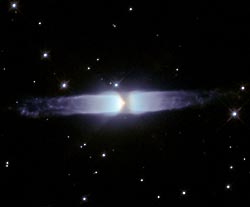
Planetary nebula Henize 3-401 in the constellation Carina as seen by the Hubble Space Telescope. This image is a composite of three exposures taken with Hubble's Wide Field and Planetary Camera 2 on June 12, 1997.
Courtesy European Space Agency and Pedro Garcia-Lario (ESA ISO Data Centre).
European astronomers released an image taken by the Hubble Space Telescope today that shows a dying star, 10,000 light-years away, surrounded by one of the most elongated planetary nebulae ever seen. Looking like a tube pinched in the middle, the nebula designated Henize 3-401 represents a short-lived phase — perhaps lasting only a few thousand years — as the star evolves into a white dwarf.
The dark area around the pinch includes a ring or disk of obscuring dust. The whole object is tilted with its left side slightly closer to us, allowing us to see past the near edge of the ring to the central star.
Astronomers are keenly interested in planetary nebulae because the scientists still do not understand exactly how they form. The process behind how huge opposing, or bipolar, outflows of gas develop from stars that were once similar to our Sun remains speculation. Is the central star orbited by an object that regulates how the star sheds its atmosphere? Or are the lobes a result of the star's magnetic field?
Future study of Henize 3-401 may help decide, Pedro Garcia-Lario (European Space Agency) explains, because unlike many other still-forming planetary nebulae, astronomers can clearly discern the central star. Furthermore, observations using a variety of instruments may glean clues about the ongoing chemical processes as the star loses more of its atmosphere.
 0
0
Comments
You must be logged in to post a comment.